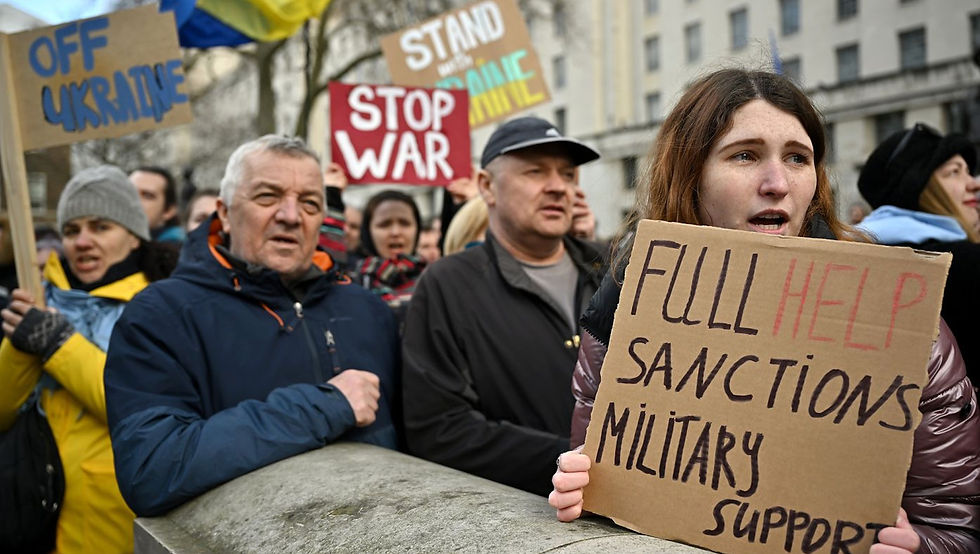Weekly Brief: Economic Nuclear Bomb on Russia
- Waseda Economics and Finance Forum
- Mar 6, 2022
- 3 min read

Background
The United States and the European Union announced major economic sanctions on Russia as Russia started to carry out its military action, de facto war on Ukraine on 23rd of February. Sanctions included trade, travel, freezing Russian bank assets, and removing Russia from the financial system. One of the most significant sanctions set forth was banning selected Russian banks from SWIFT. The impacts of sanctions started to show as the days progressed.
What is SWIFT and why is it important?
The removal of Russia from SWIFT is called an ‘unprecedented’ level of sanction by many. What is SWIFT and what is the big deal? Society for Worldwide Interbank Financial Telecommunications, or SWIFT is a cooperative founded in Belgium in 1973, intended to standardize electronic messages from banks about financial transactions. Through SWIFT, money, and assets are smoothly and safely transferred across the border. Today, about 11,000 banks and institutions from more than 200 countries are registered as members of SWIFT. Now, why is removing Russian banks from SWIFT important? SWIFT allows smooth and instant transfer of international funds. Disconnecting Russian banks from SWIFT will mean that disconnected banks will have a hard time transferring money to other financial institutions. This can also mean that customers, both individuals, and firms will have a hard time conducting business. Maria Shagina, a visiting fellow at the Finnish Institute of International Affairs mentioned the effect of removal from SWIFT "The cutoff would terminate all international transactions, trigger currency volatility, and cause massive capital outflows," (Riley,2022).
The effect of the sanction
Starting from the 28th of February, the Russian Ruble dropped significantly and reached 110 to a dollar on the 2nd of March and 118 to a dollar on the 3rd of March.

The values are continuously hitting new low records with high volatility. According to volatility analysis by V-Lab, the volatility sharply increased with the start of sanctions, and the volatility is projected to increase further as the sanctions continuously damage the Russian economy.

In accordance with sanctions, the Russian central bank increased the interest rate up to 20%. However, with a shortage of dollars and euros, the banks stopped currency exchange transactions. In addition, authorities banned all Russians from transferring foreign currencies abroad and made exporters exchange 80% of foreign currency proceeds to rubles. People started to rush to banks as the value of rubles continue to plummet.

What now?
The S&P has downgraded the Russian economy from BB-plus to CCC-minus, suggesting high default risk. Similarly, Fitch and Moody’s also downgraded Russia’s rating to junk status. Many predict that the longer the sanctions continue, the more damage they will do to the Russian economy. Maximilian Hess(2022) at the Foreign Policy Research Institute mentions the current situation as “verge of an economic collapse without parallel in its post-World War II history” and “it is now possible that most of its residents’ quality of life may fall to Iranian or potentially even Venezuelan standards in the near future.”
References
Hess, M. (2022, March 4). What's awaiting Russia may be much worse than the chaos of 1990s. Opinions | Al Jazeera. Retrieved March 4, 2022, from https://www.aljazeera.com/opinions/2022/3/4/russias-looming-economic-crisis-will-be-worse-than-1991
Hill, T. (2022, February 28). Russia ruble at all time low as Russians Spark Bank run - putin raises rates to 20%. Express.co.uk. Retrieved March 4, 2022, from https://www.express.co.uk/finance/city/1572946/russia-ukraine-crisis-ruble-bank-run-swift
Selyukh, A. (2022, March 2). How everyday Russians are feeling the impact from sanctions. NPR. Retrieved March 4, 2022, from https://www.npr.org/2022/03/02/1083694848/sanctions-russia-ukraine-economy-war
V-lab: Russian ruble GARCH volatility analysis. Real-time Financial Volatility, Correlation, And Risk Measurement, Modeling, And Forecasting. (n.d.). Retrieved March 4, 2022, from https://vlab.stern.nyu.edu/volatility/VOL.RUB%3AFOREX-R.GARCH
Hotten, R. (2022, February 27). Ukraine conflict: What is swift and why is banning Russia so significant? BBC News. Retrieved March 4, 2022, from https://www.bbc.com/news/business-60521822
Riley, C. (2022, February 28). What is swift and how is it being used against Russia? CNN. Retrieved March 4, 2022, from https://edition.cnn.com/2022/02/28/business/swift-sanctions-explainer/index.html
Thomson Reuters. (2022, March 2). Rouble hits record low in Moscow, remains volatile outside Russia. Reuters. Retrieved March 4, 2022, from https://www.reuters.com/markets/europe/russian-rouble-slips-past-100-vs-dollar-banks-hunt-fx-2022-03-02/
Thomson Reuters. (2022, March 4). S&P drags Russia's rating deeper into junk territory. Reuters. Retrieved March 4, 2022, from https://www.reuters.com/markets/deals/sp-drags-russias-rating-deeper-into-junk-territory-2022-03-03/
Xe.com. (n.d.). US dollar to Russian Ruble Exchange Rate Chart. Xe. Retrieved March 4, 2022, from https://www.xe.com/currencycharts/?from=USD&to=RUB&view=1W




Comments